Report
Uncertain times require a sharper commercial approach

Content
Increased economic uncertainty, digitalization, and information overload have changed the buying behavior of B2B customers. This means we are confronting a sales reality that places new demands on both our commercial strategy and the sales force.
Intro
Better sales performance when the rules are changing
The path to more sales opportunities and increased B2B sales changes as the customers’ buying habits evolve.
How do B2B sales organizations succeed in adapting and optimizing sales performance when the rules change?
Based on sales research and experience from hundreds of sales organizations, we share everything you need to know about the new sales reality, complemented by a series of inspiring cases.
At Intenz, we have more than 25 years of experience in helping and acting as a partner for organizations seeking to improve their sales performance. Our experience shows that the best time to challenge the status quo is when we are facing significant changes. Just as it is happening in B2B sales today.
Together, we grow smarter
In order to keep up with the changes, it is crucial that you succeed in adapting your commercial approach to the customers’ new way of buying. It is not enough to increase efforts, targets, campaigns, or training of the salespeople’s selling skills. In today’s B2B sales, it is important to see sales as a team sport, which places new demands on how we run and develop B2B sales organizations.
That’s why we have assembled a series of initiatives with inspiration on how to prepare your B2B sales organization for the new sales reality
The 5 key questions you need to know the answers to:
|
The commercial strategy
Do you have the right commercial approach?
01
Many B2B sales organizations have only just begun their journey to navigate a world that is very different from what they are used to.
A journey that not only involves creating value in the buying situation itself but, to a greater extent, throughout the entire purchasing process.
Traditionally, the buying experience has revolved around a salesperson who played a central role in advancing the process at nearly every stage of the buying process. Now that customers seek information and complete large parts of the purchasing journey on their own, this picture is changing. This also means that it’s time to evaluate whether that sales approach is the right one (which it rarely is…).
Often, one of the indicators that the sales approach does not match the customers’ buying behavior is that salespeople waste a lot of time on customers who are not ready to buy.
Your sales approach should be based on knowledge rather than gut feelings
Sales research shows that B2B sales and sales management require more strategy than focusing on the salesperson. In the sense that a strategic approach is more important than having outgoing, competitive individuals with good interpersonal skills and perhaps a dose of audacity.
In sales researcher Karina Burgdorff Jensen’s research, we see that sales organizations can improve their revenue by at least 6-8% by consciously changing their sales approach.
There are three main sales approaches:
Product value: Value is created in the product, focusing on features and benefits.
Solution value: Value is created by combining products into a solution that meets the customer’s needs.
Purpose value: Value is created in the relationship and dialogue between customer and salesperson, where the focus is on creating mutual value.
Once you have made a conscious decision about your sales approach, you can adjust your strategy, sales process, and communication to ensure they support one another.
Therefore, it is crucial to determine how your salespeople should create value for the buyers. Otherwise, you risk leaving customers with the impression that the salespeople only add very little or no value to the buying experience.
77%
of buyers agree that purchasing has become much more complex and difficult
– Gartner
70%
of the B2B buying process is completed before the buyer engages with the seller
– Sirius Decisions
B2B buyers only spend
17%
of the total buying journey with salespeople
– Gartner
As much as
80–90%
have suppliers in mind before conducting any form of research.
Light up your sales approach
You may be convinced that the most effective way to sell at your company is to tailor the best solution for each individual customer. Yet, the salespeople keep merely presenting products or talking about the technical specifications. This is a classic challenge that many struggle with.
In fact, sales research shows that in the majority of B2B sales organizations, there is little to no correlation between how B2B sales are envisioned and how they are executed. Thus, between sales philosophy and sales behavior.
This is a significant challenge that hinders success in achieving better sales results, mainly because you only truly increase sales when there is a strong coherence between your sales approach and actual sales behavior.
In fact, there is up to 15% more revenue potential for B2B sales organizations that succeed in creating coherence between sales philosophy, sales methodology, and sales communication.
But what do sales philosophy, sales methodology, and sales communication really mean? And how can you create the crucial connection?

What should customers experience when they interact with you?
Your sales philosophy reflects how you think about sales and is a clear description of how you approach it.
Let’s take a concrete example. Imagine you want to be perceived as a strategic partner who offers tailored solutions and best practices from the industry. All with the aim of helping the customer to develop their business.
In this example, it could be through:
– Always offering suggestions for improvements or developments
– Inspiring by highlighting what others are doing well
– Consistently challenging the status quo with innovative concepts
Thus, the sales philosophy sets the direction for what good sales are for you, and it makes it more clear what you want the customer to experience throughout the buying process.
The right sales method
Once you’ve set the direction and defined your sales philosophy, the next step is to adopt the right sales method. The one that supports the sales philosophy.
Continuing with the previous example, we know from sales research that the best sales methods for this scenario are typically insight-based selling or challenger selling.
Think of your sales method as a trip to the kitchen. If you want to bake a specific cake, it’s much easier when you follow a recipe. The same applies to your salespeople. If your salespeople follow a specific recipe, their sales behavior will naturally support your goals to a greater extent. Therefore, it’s about establishing the recipe for your B2B sales by defining the right sales method.
You might choose consultative selling as your sales method, where the focus is on providing unique knowledge and insights that help the customer to develop their business. Or perhaps you choose to shift focus away from the products and instead guide the sales dialogue with insights. In this case, you move away from product demos and toward opportunities and consequences based on the insights you bring to the customer. This is what your salespeople should be selling from.
The sales philosophy and the sales method serve as both the starting and finish lines when working to improve sales. Once this is in place, the big challenge is to ensure that the sales method is consistently followed.
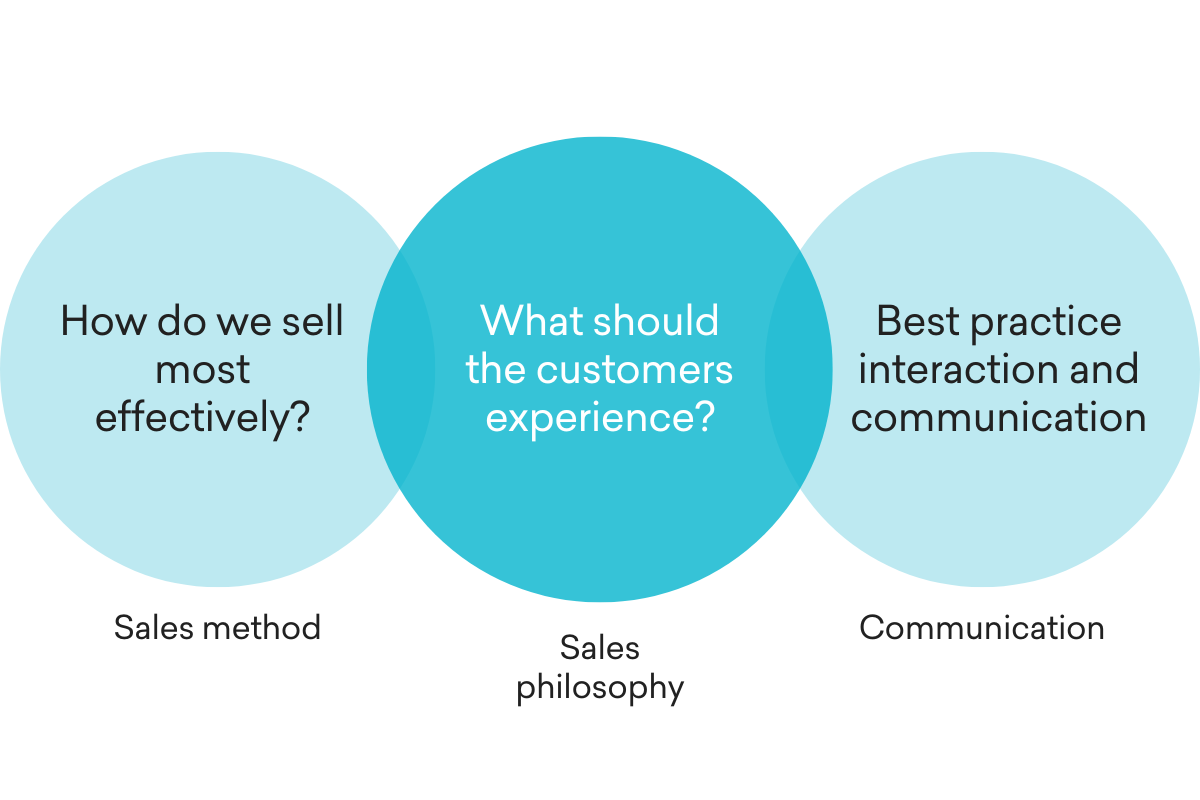
Sales communication is what the customers see
Once your sales philosophy is in place and the most ideal sales method has been chosen, the next step is to focus on the sales communication. It should align with the strategic decisions you’ve made, so everything works together.
Sales communication encompasses all forms of interaction with the customer and all the information your customers receive from you.
Here are some common things that often go wrong:
Salespeople’s habits can be so ingrained that they struggle to approach sales dialogues in a new way.
Sales and marketing materials may not be updated according to the new strategic choices, which can lock your salespeople into the old approach.
Intensive training occurs at the start, but follow-up and reinforcement are lacking, so the new knowledge isn’t anchored, and salespeople quickly revert to old habits.
The solution is to ensure that your sales leaders have both the time and the necessary skills to effectively coach the salespeople, develop the right sales communication, and remove the key barriers to make selling easier.
You shouldn't approach all customers in the same way
Customers are not the same. They come with different needs, challenges, and goals. Yet many customers are treated in the same way. That approach is outdated — it’s time to meet customers differently.
Quick upsells should be handled one way, and complex solutions in another.
While most customers want in-depth advice when investing in an expensive print solution, buying paper and toner should be easy, quick, and cheap.
Therefore, it is essential that your sales philosophy, sales methods, and sales communication are adapted to the different segments, customer journeys, and solutions. This also means that it is important to understand the different buying processes customers go through, so you can adjust accordingly.
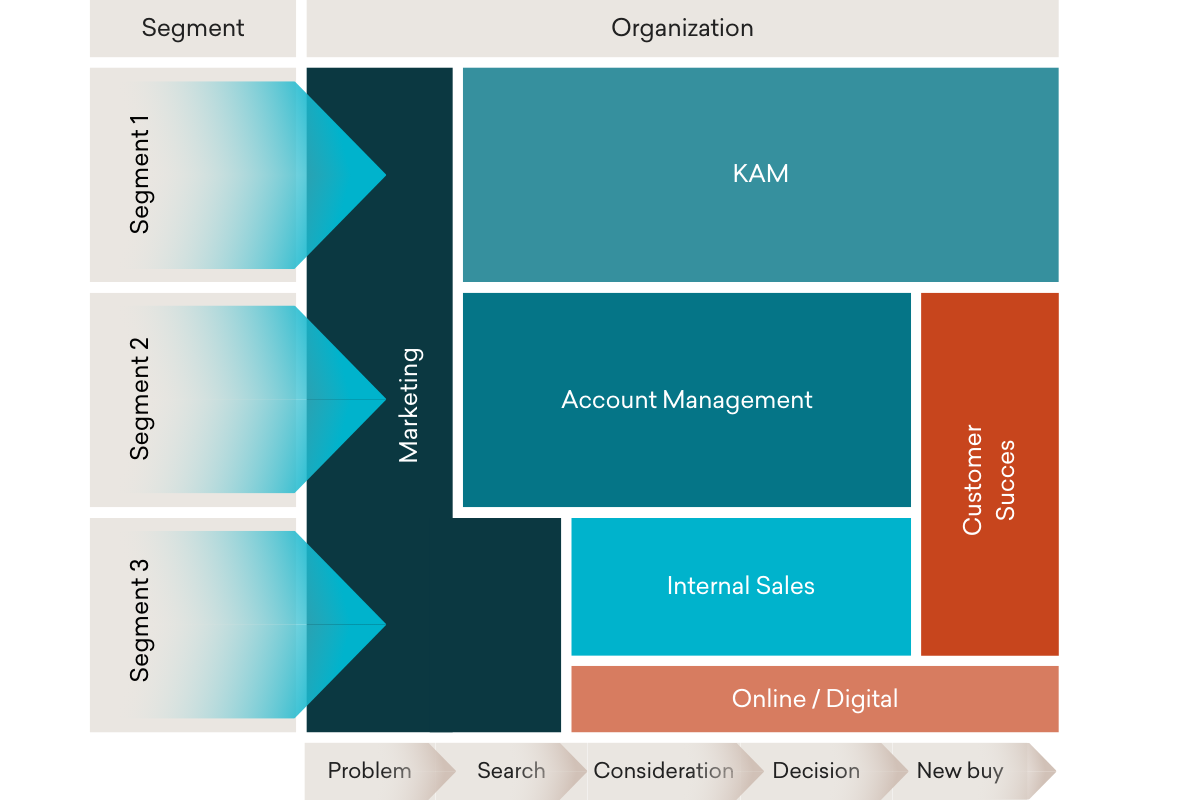
Differentiate yourselves
Are you in sync on what should differentiate you from the competitors?
02
Only about 50% of salespeople reach their targets. This means that nearly 50% fail to meet their goals. It’s getting harder and harder, and the percentage is rising. In fact, the numbers are deteriorating faster than ever before.
At the same time, we see less dialogue between buyers and sellers in B2B sales. Today, up to 80% of the decision-making process takes place without direct contact with the sales organization, an increase from 60% just a few years ago.
This makes it more important than ever to have control of the customer journey and to engage with customers in the right way. Unfortunately, this is one of the biggest challenges: commercial organizations fail to meet customers at the right place and time. Naturally, this minimizes the influence of salespeople when they do come into the picture and makes it difficult for the sales organizations to stand out from competitors.
Often, salespeople are only asked about factors such as price, delivery, and product specifications instead of being involved in discussions about what the right decision is for the customer based on their needs.
This means that the customer has essentially made their decision before the salesperson is even involved. Therefore, it is typically too late to start the sales dialogue and challenge the customer’s needs when they have already made their decision by the time contact is established between buyer and seller.
In this situation, most of us don’t like to be challenged or asked to reconsider a decision. This leads to an inefficient sales process and frustrated buyers who prefer to handle the buying process themselves without speaking to a salesperson.
And for sales organizations, this ultimately costs more sales than one might expect.
But you can also turn this to your advantage and succeed even faster and better. How? By ensuring that you answer the customers’ questions at the exact right moment in the buying process.
Outside-in is a must
Sales can learn a lot from good marketing. One key lesson is developing sales based on an “outside-in” perspective rather than an “inside-out” perspective. But this is only possible if we truly understand how the customer buying behavior has changed.
“Outside-in” means that we follow the customer journey — for example, introducing an online first meeting in the sales process if the customer journey shows that this is the right approach.
“Inside-out” means that we follow internal needs — for example, introducing an online first meeting because it would be beneficial for the salespeople, without considering its impact on the customer.
In fact, we would go so far as to claim that it’s more luck than strategy if you succeed in differentiating yourselves without mapping the customer journey.
A strong understanding of the customer journey is crucial to your success — especially because up to 80% of the buying journey may be completed before your salespeople even get involved. Therefore, you must also ensure that customers encounter relevant information elsewhere at the right moments.
Particularly in unpredictable times like now, it is critical that you have a complete understanding of the customer buying journey and how your strategy, processes, and sales behavior need to be adapted so you can differentiate yourselves as effectively as possible from your competitors.
How do B2B buyers spend their time?
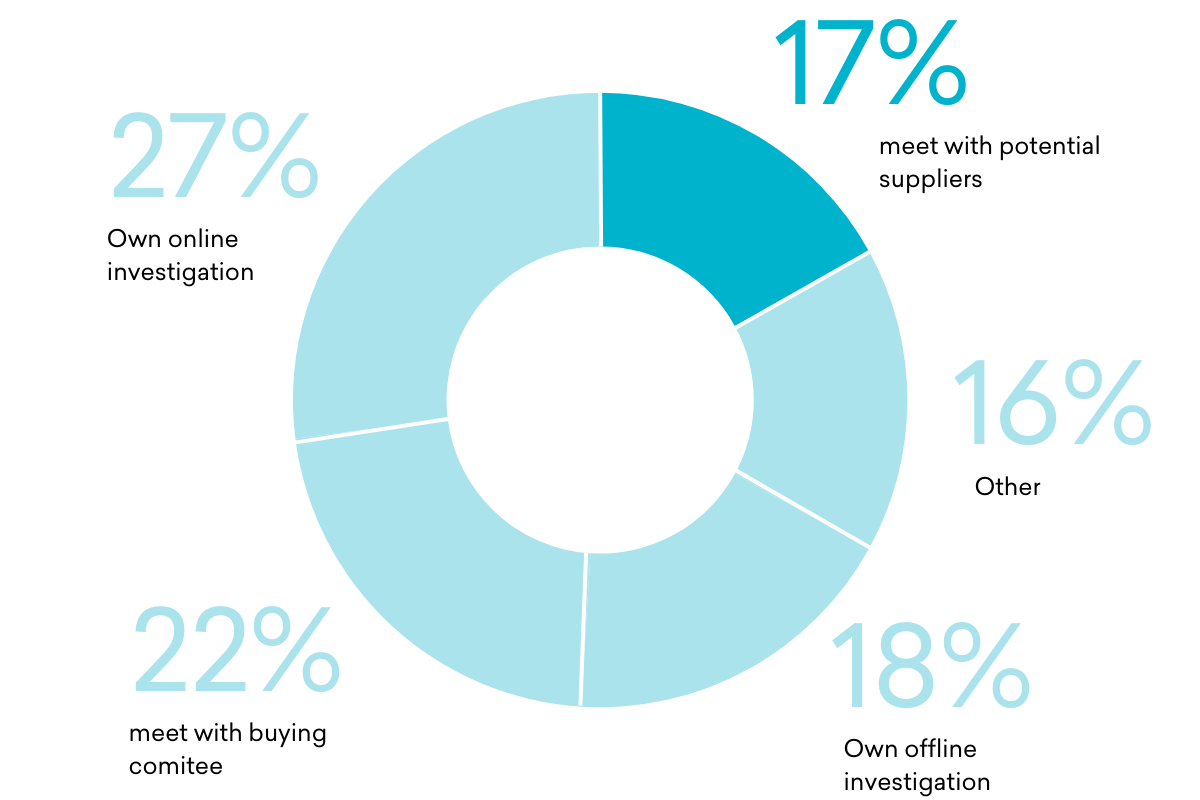
– Gartner
Analyze your customer journeys
Understanding the customer journey is crucial in B2B sales. Therefore, customer journey analysis is an important tool for gaining insights into your customers and their interactions with your sales organization. Especially when you are working on increasing sales.
Think of it as a key to optimize your sales approach — and actually tailor it to your customers’ behavior, needs, and desires.
It starts with understanding the customers: What they want, how they react, and how they experience your initiatives. At the same time, you map out your sales activities and the touchpoints that exist between you and your customers. This is the focal point of a customer journey analysis.
We analyze customer journeys together with our clients for several reasons: First and foremost, we want to understand the current sales situation. But it’s also about understanding how the current sales approach aligns with the customer’s buying behavior and your strategy.
With that foundation in place, we can work on creating alignment between customer behavior and your sales efforts. The result? The ultimate customer experience that not only brings happier customers but also boosts sales.
The typical phases of the customer journey
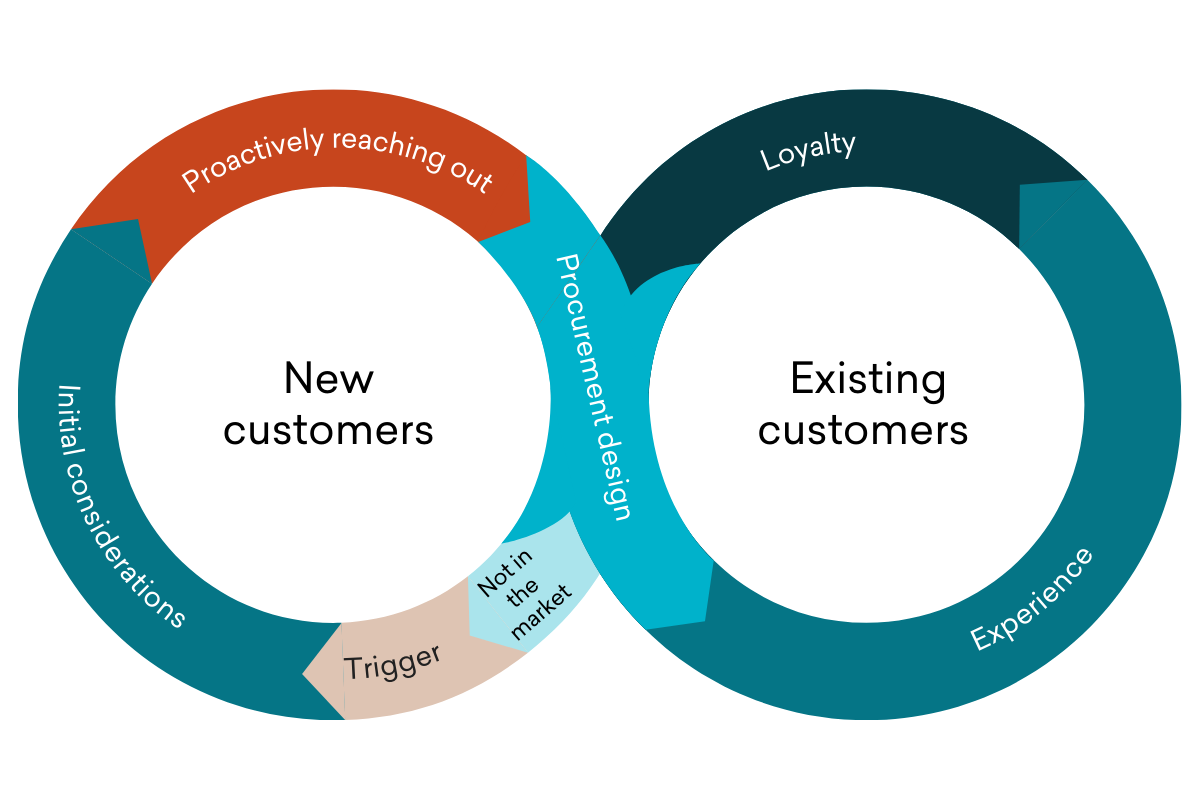
The key questions you need to know the answers to
To be more specific about what you need to know about your sales process, here are a few questions you should be able to answer:
New costumers
– What characterizes the customers you want to attract?
– Who is finding you?
– What motivates customers to start searching?
– How do customers find you?
– When does your interaction with customers begin?
– What is crucial for the customers’ final decision?
– Who is responsible for the different phases in the process of new customers?
Existing customers
– What touchpoints does the customer have with you after they have chosen you?
– When does the customer want dialogue with you?
– When does the customer want dialogue with you?
– When is the customer open to buying again?
These questions help you understand both new and existing customers’ journeys through the sales process so you better can tailor your sales approach to their needs.
Optimize the sales process
Have you optimized your sales process?
03
A B2B sales process consists of a series of predictable steps that salespeople repeat over and over: from identifying new potential customers to closing a sale.
Similarly, the customer’s purchasing process goes from experiencing a need for your product or service to making a purchase.
With the increased economic uncertainty, digitalization, and information overload, many sales organizations are facing several changes in their sales processes.
Therefore, you must ensure a clear overview and create a tailored sales process, so you apply your sales efforts where the customers experience the most value and where the return is greatest.
The buyers have more power
Today, buyers often know just as much about the products as the seller does. This is primarily because buyers spend a lot of time conducting their own research. This is a big difference from the past, where the sellers controlled the sales process.
Nevertheless, most sales processes are still based on the assumption that the seller has the power, even though the numbers show that the balance of power has shifted, and the power no longer lies solely with the seller.
Traditionally, the solution to lagging sales results has been to motivate the salespeople to do more of the same and sell more aggressively—an old-fashioned approach that acts more as symptom treatment and does not address the real problem.
Therefore, it is no surprise that studies show alarming numbers. For instance, 73% of the sales time is spent on customers who are not ready to buy, and 60% of buyers perceive sellers as directly annoying rather than value-creating.
This highlights the importance of tailored sales processes. There is a need for a reassessment of how salespeople use their time, and more focus is needed on engaging customers at the most effective and right times—when they actually can create value.
Here are some examples of different approaches to sales processes based on different buying behaviors:
Online purchase
We have a tailored sales approach that fits this type of sale. It minimizes transaction costs for both us and the customer and streamlines the purchasing process.
Hybrid approach
Do the customers want a hybrid approach, where they order based on advice? We have a sales approach that involves one or more touchpoints with a product expert who can guide the customer in potential solutions.
Inspiration
Do the customers want to be challenged in their choices and get inspiration on what they should do? Then we have a sales process that includes several steps along the way. Led by a salesperson who focuses on understanding the customers’ short- and long-term needs, is able to give customers new insights and design solutions that match their requirements.
5 signs that it is time to optimize your sales process:
– Customers find it difficult to see how you differentiate from the competitors
– Internal collaboration is lacking
– Buyers are asking for more information
– It is difficult to scale the sales organization
– Your hit rates between sales stages are low
Start with your most important goals - and get control of the sales data
Adapting your sales process might seem like an intangible task, but it doesn’t have to be.
We have found that you can more effectively manage the adaptation of your sales process by setting clear goals for what you want to achieve.
Is the goal to increase your win rate for next year by 20%? Is the goal to have 25% more deals in your sales pipeline? Is the goal something entirely different? It is important to make the goals clear and measurable.
Another important factor is sales data. When it comes to sales processes, it is often a problem that many sales organizations struggle with. They lack an overview of their sales data.
To ensure you are moving in the right direction with adapting your sales process, it is important to collect and analyze sales data. Not only to tell you about the current effectiveness but also to show you how to improve your sales process.
Increase efficiency with segmentation
Segmentation is one of the most effective ways to accelerate the efficiency of your sales process. Especially when you really go deep into segmentation.
Many are familiar with the classic approach to segmentation, which often relies on factors like size, geography, and revenue potential – the “outer beauty.”
But there is another dimension that is just as important: “Inner beauty”.
The Inner beauty refers to a deeper understanding of your customers. How do your customers prefer to work with you, how do they want to be communicated with, and how can you create the most value for them?
When you add these more in-depth parameters and optimize your segments with more perspectives, it becomes possible for you to identify the most valuable customers – not just based on size and revenue potential, but also based on value creation and collaboration. Here, you can really make a difference in the results.
These insights should then be incorporated into your sales process. The result? Stronger relations, higher lifetime value, and increased sales efficiency.
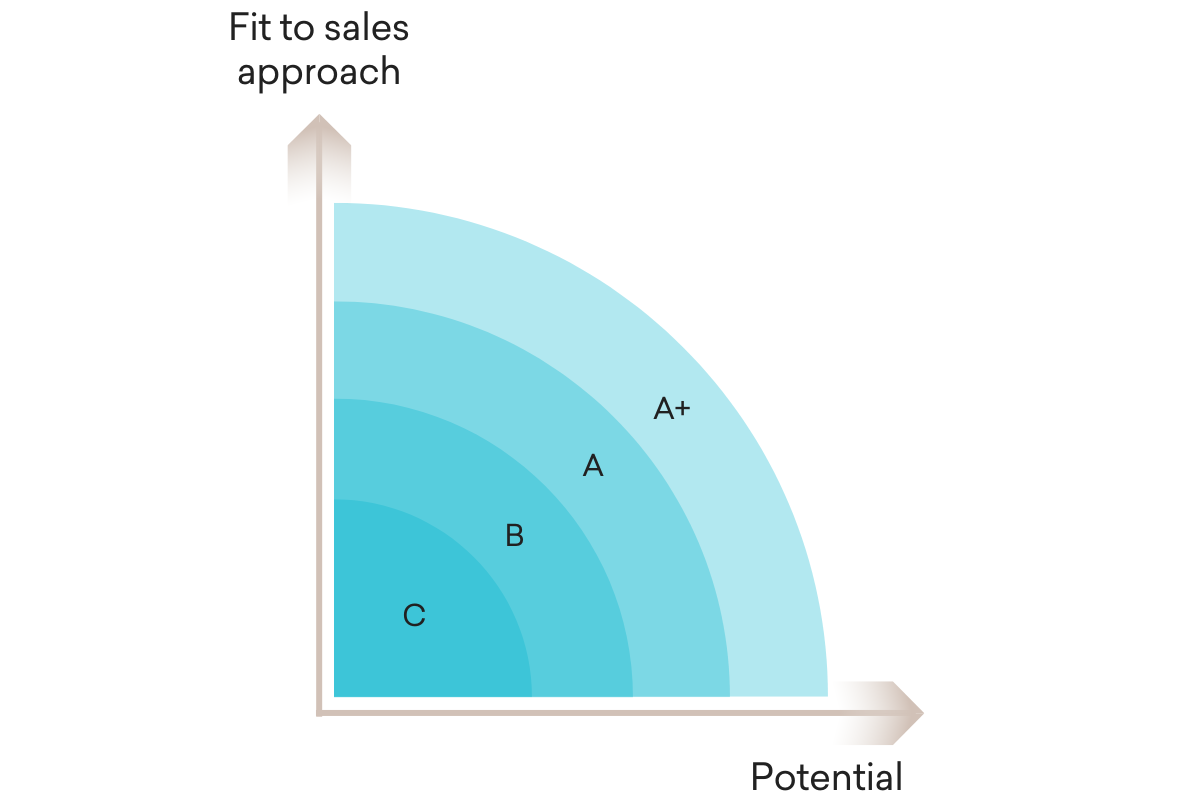
Prepare for Success
Are you setting your commercial organization up for success?
04
In today’s B2B sales, it’s a team sport. This means that the entire sales organization must work together to sell – sales, marketing, customer service, IT, and so on. Everyone who has touchpoints with the customers plays a part.
As B2B sales increasingly becomes more of a team sport than before, it places completely different demands on how you run and develop the sales organization.
If your goal is to scale and grow sales, it’s essential to implement a scalable method that can successfully drive sales as more internals become involved simultaneously.
When we think of the new sales reality, it’s no surprise that sales organizations perform better when they consciously and purposefully work to sell as a team. In fact, 68% of such organizations reach their goals compared to only 35% of those that don’t.
This shift to viewing sales as a team sport makes a big difference. So, when you aim to boost sales, it’s more about succeeding as a team rather than focusing on individual development. It’s about working together, not just as separate individuals.

A Sales Operating Model is a must
A Sales Operating Model is essential for any sales organization, in our opinion. But what is it? In short terms, a Sales Operating Model outlines your shared approach to selling and how you sell your products, services, and solutions to your customers.
It not only provides inspiration and tools for how to execute sales in the best possible way throughout the sales process, but it also includes how you create and discuss your sales pipeline, how you conduct outreach sales, and how you follow up. In other words, it covers your entire sales process.
A Sales Operating Model acts as a guide for successful sales in your organization. It helps share best practices across the sales team and supports making the right decisions at every stage of the sales process. This becomes especially valuable when you want to change the way you sell.
Greater impact from the sales efforts — without a rulebook
A Sales Operating Model also includes guidelines for how to achieve your goals with both customers, recruitment, and training of salespeople. Faster and more efficiently.
Recruiting and training salespeople can often be a long-lasting process, particularly within complex sales. A Sales Operating Model allows you to onboard new hires more efficiently while ensuring that all team members possess the necessary skills and knowledge
Thus, a Sales Operating Model is not a rulebook. It is more of an inspiration and guidance tool for salespeople, offering quick insights into what works and how to approach sales. A shared foundation.
A more efficient sales organization with Sales Enablement
Typically, sales organizations focus directly on discussing efforts, goals, campaigns, and sales skills when trying to increase sales. However, studies show that it’s more effective to dive deeper in order to analyze and understand some of the critical areas. This ensures that you make the right decisions needed to drive change and strengthen sales.
This is where Sales Enablement comes in. The aim is to create a smooth-running commercial engine, that makes it easier for the sales force to do what they’re in the organization for – to sell. Unfortunately, studies show that only 33% of salespeople’s time is actually spent selling (CSO Insights).
There are many reasons for this: Lack of activity and engagement in the sales organization, challenging systems, difficult access to the right materials, poor structure in sales processes, inadequate training and coaching, and distracting tasks, among others.
The most successful sales organizations manage to generate more sales and increase efficiency by working in a structured and focused way on a handful of crucial areas. You can see them in the model below.
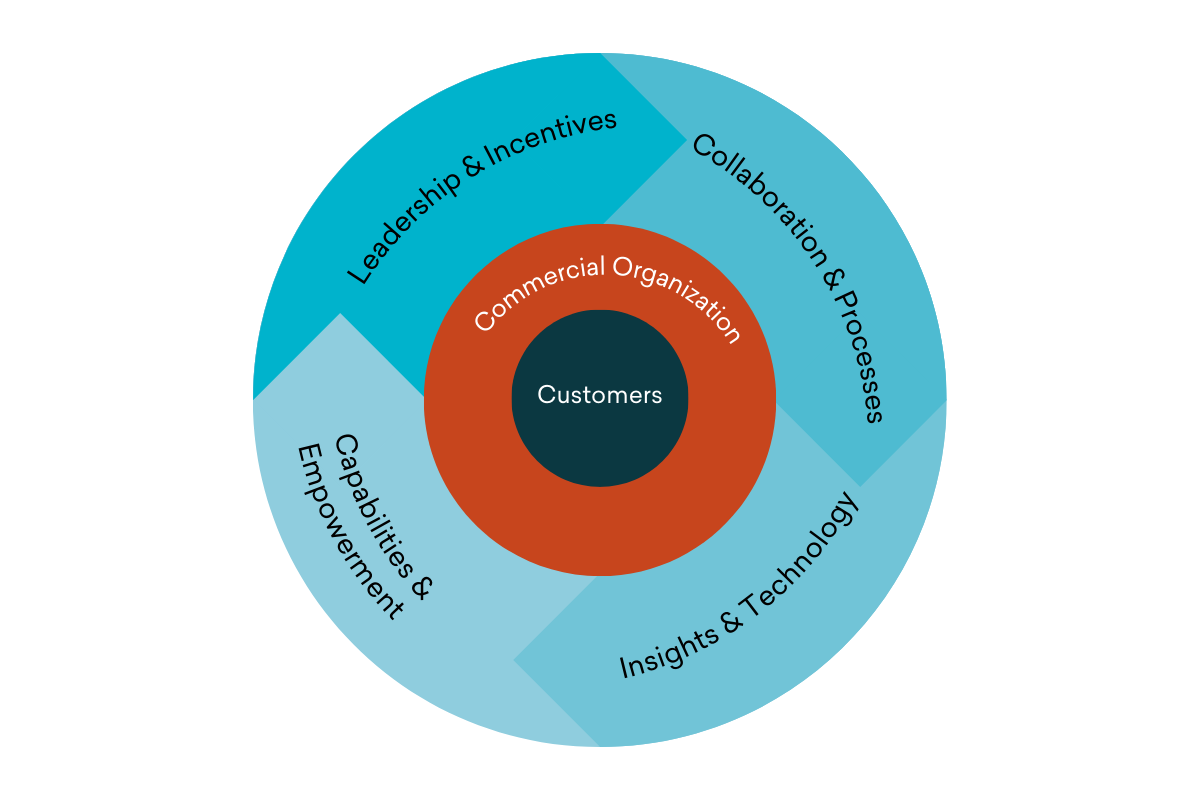
The Sales Enablement model is developed in collaboration with sales researcher Karina Burgdorff Jensen and has been tested in Danish sales organizations.
Resources & Competencies
Do you have the necessary resources and competencies?
05
Forget the diet — aim for a lifestyle change
Many sales organizations face a significant competence gap because their salespeople are not trained in sales methods that genuinely add value for customers.
Sales organizations often initiate sales training with the expectation of quick results. While this can be effective in the short term, salespeople often revert to old habits shortly after, once the daily routine kicks in again.
To achieve lasting results, we must approach sales training as a lifestyle change. The desired behavior must be widely implemented – across sales managers, salespeople, customer service, and anyone else involved in the sales process.
Whether you’re striving for the top market position, aiming to break into new market segments, or something entirely different, it is crucial that your salespeople are sharp and prepared.
Many sales leaders wish to transform their sales approach – for instance, from product-focused selling to more consultative selling. This requires new techniques and sales tools. These changes can be challenging to embed.
In fact, changing sales behavior and developing new skills can be both difficult and uncomfortable. That’s why it’s essential to approach the task of closing the sales competency gap with respect. It takes more than a two-hour workshop and some sales training. It requires a continuous effort – a lifestyle change.
Here are the five steps we use when helping our clients:
- Define clear goals for development – not just result-based goals, but also behavioral goals.
- Ensure the leaders are involved. The leaders are key to training and maintain development.
- Make sure the chosen training method aligns with your strategy and the field you’re operating in.
- Evaluate how your structures and processes support the development.
- Ensure the training is structured and continuous – preferably digitally.
What about sales management when we change the way we sell?
Improving sales leadership is one of the most impactful investments on sales results, mostly because the role of the sales leader is crucial in driving behavior change within the sales team.
Which approach to sales management that will elevate your sales depends heavily on the type of sales and the type of salespeople.
For example, short-term sales goals and a focus on meeting numbers do not align well with co-creation sales, which requires a more long-term focus. This is just one example of how different sales strategies require different sales management.
This means that sales leaders must know which sales management approach is most effective for your specific situation and have the skills to lead that particular type of sales.
Additionally, there is a wide range of competencies a sales leader must master to drive sales: Managing sales with a clear overview and understanding of your platform, having the competencies to develop the sales team’s knowledge, engagement, skills, and efficiency, finding and retaining the right talents, and fostering a strong sales culture.
That’s why equipping your sales leaders with a sales leadership playbook is highly beneficial. This playbook provides concrete structures for mastering classic sales leadership disciplines.
Therefore, it is a great advantage to equip the sales leaders with a sales leadership playbook that guides with a concrete structure to the classic sales leadership disciplines. For example:
- Coaching
- Pipeline meetings
- Feedback
- Performance reviews
- Time management and prioritization
- Reporting
- Sales meetings
- Joint customer visits
A great resource for your sales leaders and a valuable investment that can deliver substantial gains through enhanced efficiency.
Cases
Get more inspiration for developing your sales organization by exploring case studies from our collaborations with clients below. Feel free to reach out to us if you have any questions.




